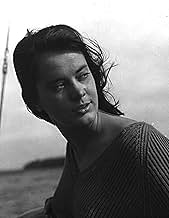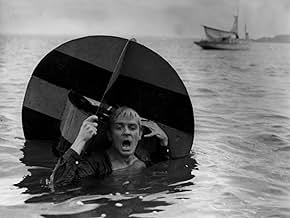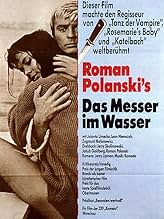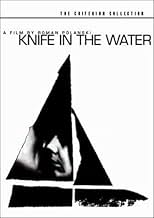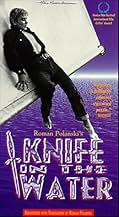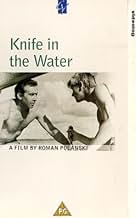IMDb RATING
7.4/10
25K
YOUR RATING
A couple pick up a hitchhiker on the way to their yacht. The husband invites the young man to come along for their day's sailing. As the voyage progresses, the antagonism between the two men... Read allA couple pick up a hitchhiker on the way to their yacht. The husband invites the young man to come along for their day's sailing. As the voyage progresses, the antagonism between the two men grows. A violent confrontation is inevitable.A couple pick up a hitchhiker on the way to their yacht. The husband invites the young man to come along for their day's sailing. As the voyage progresses, the antagonism between the two men grows. A violent confrontation is inevitable.
- Nominated for 1 Oscar
- 1 win & 2 nominations total
Anna Ciepielewska
- Krystyna
- (voice)
- (uncredited)
Roman Polanski
- Young Man
- (voice)
- (uncredited)
Featured reviews
Roman Polanski's first full length feature is a simple, minimalist piece filled with male posturing, dead end situations, claustrophobic environments and eerie calm. This is part of Polanski's art house beginnings, but many of its themes and much of its style would be carried through to his later, more accessible work.
Like many a Polanski picture, Knife in the Water shows us men competing over a woman. Typically however this is to the end of making the men look ridiculous rather than objectifying the woman. Here the competition is the central theme, and the bulk of the film is basically a series of set pieces in which the middle-aged husband and the young hitchhiker attempt to outdo each other or show the other up. This drama is concentrated and focused by having only the three characters, and confining the action almost entirely to one location. This kind of minimalism is a safe, simple way to make a straightforward, uncluttered story a good strategy for an up and coming director but it's a lot harder to make a really great picture out of such simple elements, and the young Polanski does fall somewhat short here.
What Polanski does have is his natural talent and feel for cinematic form. His sense of rhythm was evident from his earliest shorts, and by this point he had clearly settled upon a style of slow, even paces, letting scenes take as much time as they needed and never being afraid to hold a shot into so-called "dead time" if he felt it was necessary. Often, the stillness of Polanski's pictures could build up a greater feeling of dread or tension than speed and shocks. Here, the pace is leisurely, in tune with Komeda's breezy jazz score, a sound synonymous with early Polanski. It may be slow but Knife in the Water has great atmosphere.
Another of Polanski's strengths was in his feel for space, particularly confined space. In Knife in the Water we have a kind of contradiction on this level, because a small boat in the middle of a lake is both a very wide open space and a small confined one. You kind of get half the effect of a later Polanski picture such as The Tenant you do get the sense that the characters and the camera itself are incredibly restricted in their environment, but of course you don't get that feeling of all the walls pressing in on you. Nevertheless, Polanski was a master at creating this sense, and he does tend to surround the camera with bits of boat or actor. There are numerous close-ups typical of the early Polanski although it's something he would drop later in his career which give a slightly surreal look to some of the shots. A particularly effective moment is the first shot of the boat drifting out across the lake with trees dotted in the background, which then cuts to a close-up of Krystyna, the wife, lying on her back filling the lower half of the frame, with the exact same background as the previous shot.
Knife in the Water is a fairly good film with some good ideas. It suffers a bit from style over substance but is well acted and well directed and is not long enough to get overly tedious. Better things were to come from Polanski once he moved out of Poland and began his English-language film career.
Like many a Polanski picture, Knife in the Water shows us men competing over a woman. Typically however this is to the end of making the men look ridiculous rather than objectifying the woman. Here the competition is the central theme, and the bulk of the film is basically a series of set pieces in which the middle-aged husband and the young hitchhiker attempt to outdo each other or show the other up. This drama is concentrated and focused by having only the three characters, and confining the action almost entirely to one location. This kind of minimalism is a safe, simple way to make a straightforward, uncluttered story a good strategy for an up and coming director but it's a lot harder to make a really great picture out of such simple elements, and the young Polanski does fall somewhat short here.
What Polanski does have is his natural talent and feel for cinematic form. His sense of rhythm was evident from his earliest shorts, and by this point he had clearly settled upon a style of slow, even paces, letting scenes take as much time as they needed and never being afraid to hold a shot into so-called "dead time" if he felt it was necessary. Often, the stillness of Polanski's pictures could build up a greater feeling of dread or tension than speed and shocks. Here, the pace is leisurely, in tune with Komeda's breezy jazz score, a sound synonymous with early Polanski. It may be slow but Knife in the Water has great atmosphere.
Another of Polanski's strengths was in his feel for space, particularly confined space. In Knife in the Water we have a kind of contradiction on this level, because a small boat in the middle of a lake is both a very wide open space and a small confined one. You kind of get half the effect of a later Polanski picture such as The Tenant you do get the sense that the characters and the camera itself are incredibly restricted in their environment, but of course you don't get that feeling of all the walls pressing in on you. Nevertheless, Polanski was a master at creating this sense, and he does tend to surround the camera with bits of boat or actor. There are numerous close-ups typical of the early Polanski although it's something he would drop later in his career which give a slightly surreal look to some of the shots. A particularly effective moment is the first shot of the boat drifting out across the lake with trees dotted in the background, which then cuts to a close-up of Krystyna, the wife, lying on her back filling the lower half of the frame, with the exact same background as the previous shot.
Knife in the Water is a fairly good film with some good ideas. It suffers a bit from style over substance but is well acted and well directed and is not long enough to get overly tedious. Better things were to come from Polanski once he moved out of Poland and began his English-language film career.
Devastating and beautiful early film from talented director Roman Polanski...but 'beautiful' in a sad, melancholy sense. Rarely have I seen a picture which so vividly captures the wonder of weather (gray and drizzly skies and choppy sea water, illuminated suddenly by a burst of sun rays). Sure, the film is in black-and-white, however that foreboding sky actually becomes a character in the plot involving a couple out for a boating weekend who pick up a hitchhiker and invite him along on their trip. Not a whole lot of story (in the conventional sense), though both Jerzy Lipman's amazing cinematography and Krzysztof Komeda's jazzy score make the journey a worthy ride which builds in suspense and a creepy, muted kind of ambiance. Polanski's eye is unerring, but don't expect him to give into a big pay-off. The narrative is pretty much based in reality--it's grounded--and is without major outbursts, violence or melodrama. *** from ****
In Polanski's feature debut, "Knife in the Water," strange power games were again to the fore, with ridiculous macho rivalries arising when a young looking man hitches a lift with a sportswriter and his attractive wife
Though the plot itself is slim, the film is distinguished by Polanski's precise visuals, which point the shifts in allegiance between the three characters through subtle groupings; impressively, although almost the whole film is situated on a small yacht, the effect is always cinematic rather than theatrical
Polanski's film is implicit, ingenious, mesmerizing, and has artistic integrity It is filled with a very different sort of suspense There is no violence The suspense is hinted at, suggested, refined tautly, glimpsed, did-he-mean-what-I-think-he-meant?
The rich man's confidence was in his possessions, among which was numbered his attractive wife, lying in bikini, teasing by arousing expectations between them on the deck The student's confidence, casual, almost unaware, was in his very being... The husband resented the youth, the strength, the "cool," the easy virility of the student and worked out a compulsion to keep challenging them, to try to show his superiority
Polanski was fair each had his own strengths and skills; but the one obsessively resented the others
Polanski's film is implicit, ingenious, mesmerizing, and has artistic integrity It is filled with a very different sort of suspense There is no violence The suspense is hinted at, suggested, refined tautly, glimpsed, did-he-mean-what-I-think-he-meant?
The rich man's confidence was in his possessions, among which was numbered his attractive wife, lying in bikini, teasing by arousing expectations between them on the deck The student's confidence, casual, almost unaware, was in his very being... The husband resented the youth, the strength, the "cool," the easy virility of the student and worked out a compulsion to keep challenging them, to try to show his superiority
Polanski was fair each had his own strengths and skills; but the one obsessively resented the others
While driving to sail with his wife Krystyna (Jolanta Umecka) in his yacht, the arrogant and wealthy Andrzej (Leon Niemczyk) "stumbles" with a drifter (Zygmunt Malanowicz) in front of his car hitchhiking on the lonely road. Andrzej gives a ride to the young man with despisal. When they reach the marina, Andrzej unexpectedly and without any reason invites the young man to sail with them, initiating a tense dispute of power with the youth, in a claustrophobic and erotic environment.
"Nóz w Wodzie" is a claustrophobic, tense and erotic little movie of the earlier career of Polanski. The simple story is supported by a magnificent cinematography and camera work with unusual angles, and great performances of the lead cast. The Brazilian DVD shamefully misses many subtitles, leaving without translation many sentences in the dialogs. I immediately recall at least two movies that used concepts of this screenplay: "Dead Calm" and the open end of Adrian Lyne"s "Unfaithful". My vote is seven.
Title (Brazil): "Faca na Água" ("Knife in the Water")
"Nóz w Wodzie" is a claustrophobic, tense and erotic little movie of the earlier career of Polanski. The simple story is supported by a magnificent cinematography and camera work with unusual angles, and great performances of the lead cast. The Brazilian DVD shamefully misses many subtitles, leaving without translation many sentences in the dialogs. I immediately recall at least two movies that used concepts of this screenplay: "Dead Calm" and the open end of Adrian Lyne"s "Unfaithful". My vote is seven.
Title (Brazil): "Faca na Água" ("Knife in the Water")
WELL,you can defined this great film just by one particular scene: the old man is rich,have good social position and took the boy on board to play the role of his mentor.However the young man was dragging the beautiful knife,which was_as he claimed_ the most important thing in his life.The guy was always playing the knife between his fingers and the old man was jealous about that.So when the boy went inside the yacht leaving the knife,the old man took the knife and tried to do the same.Suddenly the young appear and saw this.The only way for the old man to get away with some honour was to allow the boy do the play:he played the knife between the old man's fingers,looking straight into his eyes.Well the lady at the same time was swimming using a funny rubber cocodrile.So, imagine this beautiful scene with the knife,all the tension and suddenly we hear the woman shouting:'Andrzej, Andrzej,the cocodrile is making the bubbles',huh,when I was in the cinema the whole audience burst laughting after hearing that!. The woman stays in the background, just think why? There's another great funny shot when the woman lays there for a sunbathe with her small bikinis,well, her breast dominates the scene!. is the waving movement of the yacht who creates the sensual scene!.
Of course this scene was part of the longer plot ,the critics described this `knife scene' as the most famous and symbolic scene in all of Polanski films..Zygmunt Malanowicz,the actor who played the part of the young man said that he practice a lotnfor those scenes,polanski was afraid if he was prcticing long enough,finally everything was Ok.As Leon Niemczyc,the actor who played the mature role said" Malanowicz only gave me sligh scars'.The idea of the film was the strange competition between this two men.the jury and the prize was the woman.Polanski said he needed a actress that looked plain and normal in ordinary dress but intriguing in bikini!.
Polanski was not only interested in this kind of personages,he likes the relantionship between' the master and the servant' The domineering and the repressed ,as we can see in his short film' The Fat and the Lean' (1961, B&W, 15mins) or in features like Knife in the Water (1962); Cul-de-sac (1966);Dance of the Vampires(1967) etc.
Of course this scene was part of the longer plot ,the critics described this `knife scene' as the most famous and symbolic scene in all of Polanski films..Zygmunt Malanowicz,the actor who played the part of the young man said that he practice a lotnfor those scenes,polanski was afraid if he was prcticing long enough,finally everything was Ok.As Leon Niemczyc,the actor who played the mature role said" Malanowicz only gave me sligh scars'.The idea of the film was the strange competition between this two men.the jury and the prize was the woman.Polanski said he needed a actress that looked plain and normal in ordinary dress but intriguing in bikini!.
Polanski was not only interested in this kind of personages,he likes the relantionship between' the master and the servant' The domineering and the repressed ,as we can see in his short film' The Fat and the Lean' (1961, B&W, 15mins) or in features like Knife in the Water (1962); Cul-de-sac (1966);Dance of the Vampires(1967) etc.
Did you know
- TriviaThe first scene in the film shows Andrzej and Krystyna driving a car. As shooting from the platform in front of the car was not yet available, the crew was tied to the car, standing on its mask. To get the proper light effects, they held a blanket with a small hole for the camera. Leon Niemczyk (Andrzej) was really driving this car quite fast (this was crucial to this scene), but he couldn't see anything. He drove the car using the tops of the trees to imagine where the road is.
- GoofsWhen the young boy is trying to stabilize the Christine by hanging off its side, the railing of the camera boat can be seen in the lower left-hand corner of the screen.
- ConnectionsEdited into Spisok korabley (2008)
- How long is Knife in the Water?Powered by Alexa
Details
- Runtime
- 1h 34m(94 min)
- Color
- Sound mix
- Aspect ratio
- 1.37 : 1
Contribute to this page
Suggest an edit or add missing content


